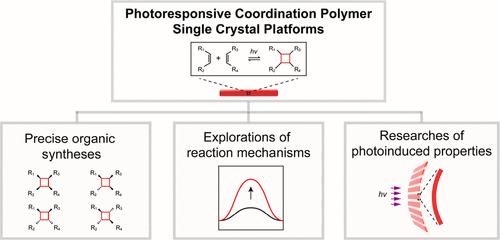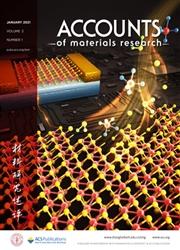Photoresponsive Coordination Polymer Single Crystal Platforms: Design and Applications
IF 14
Q1 CHEMISTRY, MULTIDISCIPLINARY
引用次数: 0
Abstract
The concept of photoresponsive coordination polymer (CP) single crystal platforms (CPSCPs) is based on photoresponsive olefin CP single crystals, which can undergo photocycloaddition reactions under light irradiation through a single-crystal-to-single-crystal (SCSC) transformation. Taking advantage of the coordination of olefin ligands to metal ions of Zn2+, Cd2+, etc., a pair of C═C double bonds is positioned adjacent to each other in space at a suitable distance and orientation to allow [2 + 2] photocycloaddition triggered by UV–vis irradiation, affording cyclobutanes in the CPs. The single crystal nature of CPs allows their structures to be determined by X-ray diffraction, providing details of the arrangements in space of the C═C double bonds. These CPs are promising platforms for the synthesis of organic molecules, such as cyclobutanes and derivatives, with high regioselectivity and stereoselectivity without any catalyst. The [2 + 2] photocycloaddition reactions may induce structural modifications like expansion or shrinking of unit cells, resulting in macroscopic changes (e.g., cracking, bending, etc.) of the whole CP single crystals and leading to changes in chemical and physical properties. Applications take advantage of their optical properties, including luminescence and absorption, and allow the detection of guest molecules and photomechanical motions. Although much effort has been devoted to such studies, it remains challenging to develop systematic investigations aiming at increasing the diversity of CPs and properties to meet practical needs. Moreover, more efficient methods are desirable to investigate the reaction mechanisms in the solid state and monitor the structural changes occurring during the process.

光响应性配位聚合物单晶平台:设计与应用
光响应性配位聚合物(CP)单晶平台(CPSCPs)的概念是基于光响应性烯烃CP单晶,在光照射下通过单晶到单晶(SCSC)转化发生光环加成反应。利用烯烃配体与Zn2+、Cd2+等金属离子的配位,在空间上以合适的距离和方向排列一对C = C双键,使紫外-可见照射引发的[2 + 2]光环加成作用在CPs中生成环丁烷。CPs的单晶性质允许通过x射线衍射确定它们的结构,提供C = C双键在空间中的排列细节。这些CPs是有前途的平台,用于合成有机分子,如环丁烷及其衍生物,具有高的区域选择性和立体选择性,无需任何催化剂。[2 + 2]光环加成反应可引起单晶膨胀或收缩等结构修饰,导致整个CP单晶发生宏观变化(如开裂、弯曲等),从而导致化学和物理性质的变化。应用利用其光学特性,包括发光和吸收,并允许检测客体分子和光电运动。尽管在这方面的研究已经投入了大量的努力,但要开展系统的调查,以增加cp和属性的多样性,以满足实际需要,仍然具有挑战性。此外,需要更有效的方法来研究固态反应机理和监测过程中发生的结构变化。
本文章由计算机程序翻译,如有差异,请以英文原文为准。
求助全文
约1分钟内获得全文
求助全文

 求助内容:
求助内容: 应助结果提醒方式:
应助结果提醒方式:


